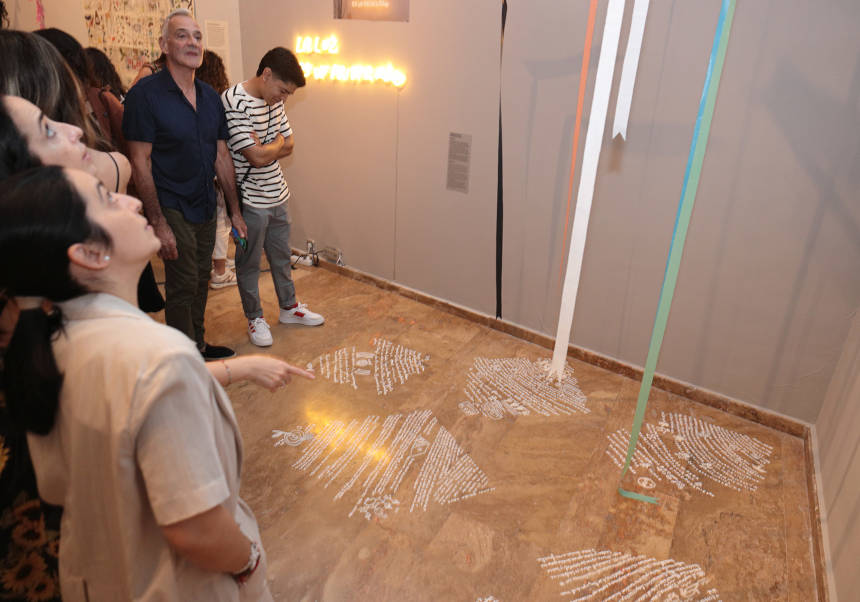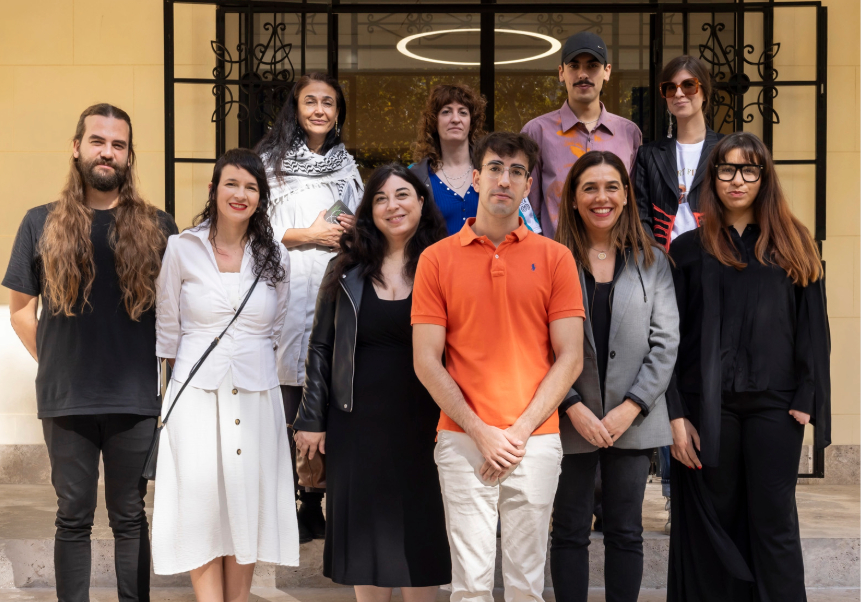The Martínez Guerricabeitia releases a new season with the collaboration of the artivist ‘Contra-Huellas’
- UV General Foundation
- M. Angelica Morales Lopez
- October 4th, 2024

The Martínez Guerricabeitia Collection of the Universitat de València inaugurates this Thursday, 3rd, at 6:30pm, the exhibition ‘Contra-Huellas. Artistas ecologistas frente a la crisis medioambiental’, that will be exhibited in the Sala Martínez Guerricabeitia from the Centre Cultural La Nau until 23 February 2025.
Organized through the Office of the Vice-Principal for Culture and Society, with the management of the UV General Foundation, ‘Contra-Huellas’ is the protest for a project that, in the words of its curator, the cultural mediator Eugenia Rojo, “arises in a context of unprecedented ecologic crisis” that pretends to sum up to the “fundamental role of culture” in answer to the environmental emergency.
Consequently, ‘Contra-Huellas’, a collective exhibition of five compromised artists, is defined as “a proposal where art and ecology converge promoting a critical and active awareness against the ecological contemporary challenges”.
In this sense, Eugenia Rojo highlights “the importance of the art institutions to make public this type of protests and support the emerging artists”, who “are really, really compromised artists because they live as they preach, work in environmental education, in the rural areas, along with communities in which they are really thrown into and in the reality surrounding the people”. She adds: “I found it important to give them a voice”.
The thesis of the exhibition has two basis: science and nature. “It’s a project with depth that involves scientific, technical and handmade type of work, and not the type that is now trend: the art and the ecology that entails a “greenwashing” which doesn’t go beyond the image”, says the curator.
The exhibit presents more than fifteen artistic works, most of them re-contextualized, among facilities, graphic works, photography, videos and sculptures. The materials are usually reused to minimize their environmental impact, as well as their production: no frames, no plastic and always lowering the brightness. There is even a proposal that measures the environmental footprint of the project, taking part in the research of the CO2 footprint in art, as well as its mental consequences in human beings, far from the “wild and abrupt nature”.
Eugenia Rojo chooses the title ‘Contra-Huellas’ to, in a figurative way, fight against denialism over climate change and the emergency situation with environmentalism in which the world is right now. She explains that everyone, with our actions, leave our carbon footprint in the planet, this exhibition included, which wants to be configured as an “anti-footprint” from a conceptual point of view to change the mentality — and so the active viewer reads the gussets — something that, for the record, is not done in contemporary art — because the goal is the dissemination of ideas and to conclude the artistic work with reading comprehension and critical thinking.
The artists
‘Contra-Huellas’ is the result of the doctoral thesis by Eugenia Rojo, who bet for an exhibiting project that talks about “environmental justice and climate change”, about how their effects are devastating for the continuity of some of the animal species, as well as for the people who are obliged to migrate due to the lack of water.
The five artists work over these lines and will expose their work in La Nau. They are:
Graham Bell (Aberdeen, 1966), of scientific training and means of expression like the performance, video, music, graphic art, photography, drawing, “he is a very peculiar artist with a different approach that lets me show a side of ecology which is different from the landscape”, indicates the curator, who points that his performances are rituals that propose changing traditional ceremonies to avoid the extinction of animals, an idea to which he dedicates two tributes in the exhibition.
Míriam Martínez Guirao (Elche, 1981) is a multidisciplinary artist with a narrative that evolves around ecology and its link to environmental psychology, responsible of the study of the CO2 footprint in the exhibition and the psychologic consequences of the climate change in people. Míriam works techniques, like drawing, ceramics, archive or wood.
Bea Millón (Sagunto, 1992), in turn, contributes with an eco-aesthetic view through the study of socio-cultural relations and their surroundings. As Eugenia Rojo said, her work is straightforward with the communities and the people, and she narrates as an example the initiative of Millón en Santa Pola (Alicante) where she took care of the migrant community and of which she raised awareness of flying in a plane that left the following message: “There are as many waves as deaths in the sea. No migrant is illegal”. Therefore, as the curator tells, its visibility, it could be said, lies between art and activism, and is executed from a non-colonial perspective.
Marco Ranieri (Milán, 1984), equally close to the people, wants to establish a dialogue between the environment and its inhabitants using materials from the landscape which give to his work a botanical and natural aesthetic. “He may be the most classical from them all, but it looks quite pleasing”, Eugenia points out. Interested in the biodiversity and symbiosis between nature and the human being, he uses objects, food, vegetables, even oral documentation... to bring his art to life.
Finally, Chiara Sgaramella (Cerignola, 1982) points out the links established between natural ecosystems and human societies, developing her field work in rural areas and urban vegetable patches in order to find alternative agricultural techniques for a sustainable food production that is also respectful with the environment.
In the end, knowledge, experimentation with nature, the countryside, rural or urban areas but mostly with people, who, as the curator insists in the description of ‘Contra-Huellas’, fight against an “alarming” loss of biodiversity, contamination, waste crisis and climate change.
More information:
Categories: Cultura , Exposicions , Centre Cultural La Nau , Fundació General UV , Col·leccions



.jpg)













